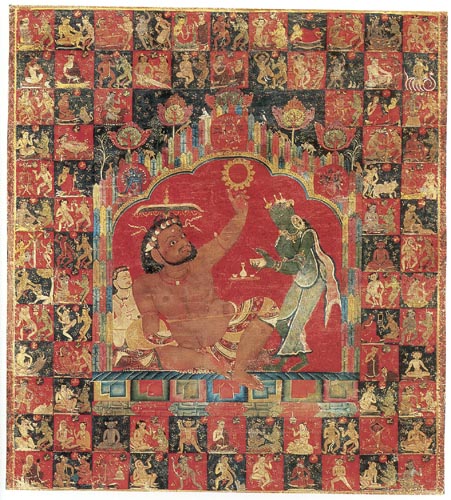| 35. Virupa
|

35.
Virupa
Tibet (Sakya monastery), ca.
second quarter of the 13th century
Distemper on cloth
55.9 x 49.8 cm (22 x 195/8in.)
The Kronos Collections
|
The corpulent mahasiddha Virupa is seated, supported by a meditation strap and by his lowered right hand. With his raised left hand he points toward a disk that probably represents the sun. To his left stands a woman with green
skin who proffers a skull cup (kapala) as a tray set with a wine flask and cups floats between them. Behind Virupa sits a small bearded figure holding a ritual implement whose bottom half disappears into another skull cup. The scene is set beneath a five-lobed arch surrounded by stylized mountain staves that rest on cubelike rocks. Three small deities appear within aureoles in the upper frame: a Chakrasamvara and consort on the right, a Vajrayogini at the center, and a Hevajra and consort to the left. Eighty-two vignettes set within squares surround the central figures; each contains a scene from the life of one of the mahasiddhas.
The central image probably alludes to a crucial moment in the life of Virupa. While studying at Nalanda monastery, he became discouraged when he felt that his meditation on Chakrasamvara had been unsuccessful. In a
dream he received instruction in the mysteries of Hevajra from the goddess Vajrayogini and finally achieved an
enlightened state. He then gave up his cloistered existence and, abandoning the robes of a monk, began to
lead the life of a wanderer. One day he reached a tavern and ordered beer from the serving maid. He drank again and again, to the point where the maid became distressed that he might not be able to pay his bill. She asked for payment, and he agreed that he would stop drinking at noon. He then raised his hand and stopped the sun in its path. After Virupa had been drinking for three days, the local king came to restore cosmic order. He paid Virupa's bill, and the mahasiddha relented. The incident is symbolic of Virupa's transcendent wisdom, the power of which could stay the passage of time and, therefore, the stream of existence.
In the painting, the maid has been transformed into a green-skinned goddess, perhaps Tara, the Buddhist savioress. The skull cup, a common Tantric appurtenance, is offered not only here, where the wine cups and flask remain untouched on the tray, but also in the surrounding vignettes, where rondelles contain hands that offer a skull cup to the siddhas below. By extension, the skull cup is a symbol of Tantra and its transcendent wisdom. According to legend, Virupa appeared to the founder of the Sakya order, Kham Konchok Gyelpo (1034-1102), and instructed him in the Hevajra Tantra. This doctrine is the central component of the Sakya teachings.1 An inscription on the reverse states that Virupa is surrounded by his retinue of eighty mahasiddhas, whereas eighty-four is the canonical number. Although some of the eighty-two surrounding siddhas can be identified, at least half seem to be generic portrayals, which seems to indicate the lack of a specific iconographic instruction manual that the artist could follow.2
The style of the painting is almost purely Nepalese; the only Indian element is the lobed arch surrounding the
principal scene. The animated figures, with round faces and stylized physiognomies, are purely Nepalese, as are
many of the motifs: the prismatic rocks, the trees shaped like lollipops and surrounded by foliate plumes, and the
swirling foliate rondelles that fill the background of the main scene (the earliest appearance of this last motif). This motif became extremely popular in the fourteenth and fifteenth centuries, when it was used to embellish what would otherwise have been solid fields of color (see cat. nos.
45-47). The mountain staves are common to both traditions, but in the Nepalese version they take on a more blunted form.
The painting is particularly important because it has an inscription stating that "the rite of
consecration of this [painting] of the Great Lord of Yoga, Virupa, with his retinue of eighty mahasiddhas was done by
Sakya Pandita."3 Sakya Pandita (1182-1251) was the lineage holder of Sakya monastery from 1216 until his death. He was summoned in 1244 by the Mongol prince Goden (the
second son of Khan Ogodei) and reached Liangzhou in 1247, never to return to Tibet. Therefore, it is likely that the painting was executed sometime between 1216 and 1244. It is the only thirteenth-century painting made by a Nepalese artist for a Tibetan patron that can be securely dated as well as definitively associated with Sakya monastery. It is
also one of the very few early Tibetan paintings known to have been consecrated by an important hierarch.
SMK
1. Deshung Rinpoche 1995,
p. 9; see also Kossak 1997, pp. 33-35. [back]
2. Linrothe 1995. The tally of eighty-four may be arrived at if
Virupa and his male companion are added to the eighty-two vignettes. This still does not explain the inscription which, to
be correct, should read eighty-two or eighty-three. [back]
3. Translation by Jane Casey Singer. [back]
|
